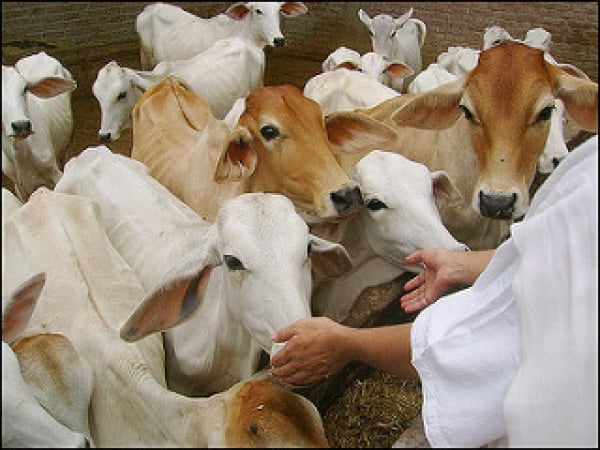
Viceroy Lord Linlithgow to Shankarrao Chitanvis: Journey of Gaolao Breed
Interview with Dr. Arun Sirothia
Ex Head, Department of Genetics and Breeding, Nagpur Veterinary College
Q. Can you give insight into how Gaolao breed evolved? When was it recognized as a new breed?
Vidarbha region is fortunate to find its reference in Ramayana and Mahabharata. When one wants to trace out the history and evolution of Gaolao, then one will have to study the epics of Mahabharata where Lord Krishna fell in love with princess Rukhamini who was the daughter of Vidarbha King “Bhishma” of Kaundanyapur a place presently christened as Amravati. After seeing so charming and beautiful Rukhamini, Lord Krishna sent a marriage proposal to her father which was rejected and ultimately ended in war. It is said that Lord Krishna came with warriors and cows and won the war and later on eloped with her. Vidardha being calm and pleasant place, few of his solders preferred to stay back along with their precious cattle wealth Gaolao. After marrying Lord Krishna took Rukhamini with him but donated cows to locals called ‘Gaoli’ who reared and propagated these animals. This might be the probable reason why these animals were referred to as “Gaolao”. It is also claimed that during Rig-Veda, Aryans migrated from northern peninsula towards south through hilly areas of Satpuda ranges along with few herds of cattle which later on spread to entire Vidarbha region, especially Wardha district of Maharashtra and adjoining area of Chindwada district of Madhya Pradesh . Though the Gaolao animals were popular among the local farmers since long but the policy makers and scientific fraternity did not realize the importance of this precious genetic resource of the region. Viceroy Lord Linlithgow in the year between 1934 to 1943 established good Gaolao Breeding Farms near Chanda (Chandrapur), Yavatmal, Pohra(Amravati). Few years later Shri. Dadasaheb Deotale then State Minister Irrigation, Govt of M.S. established Gaolao Cattle Breeding Farm at Hetikundi (Wardha) approximately about 65 km from Nagpur. Similarly, Shri. Dharysheelrao Wagh from Rohna village (Arvi), Shri. Tatyasaheb Kharade (Kinhala) and Shri. Mohamad Yusuf from Arvi were the prominent Gaolao cattle breeders who were instrumental in propagating and developing this precious genetic wealth of Maharashtra. According to Shri. Shankarrao Krishnarao Chitanvis (1970), a then renowned Gaolao breeder and owner of Gaolao Control Breeding Farm Nagpur, Gaolao cattle shares phenotypic resemblance with Bhagnari cattle breed from Bhag territory of Jacobabad in Baluchistan district of northern Pakistan. This breed also has close phenotypic similarities with Nellore (Ongole) breed from southern India especially Nellore district of Andhra Pradesh. He further opined that Gaolao cattle might have been evolved during the process of transhumance resulting into intermixing of above two breeds in Shankarrao Chitanvis the central India.
In fact Gaolao is not a newly recognized breed of cattle but it is in fact one of the extant breed registered in the year 2008 by NBAGR under the aegis of ICAR amongst other 30 already known cattle breeds of India with Accession No INDIA_CATTLE_1110_GAOLAO_03006.
Q. Can you give insight into how Gaolao breed evolved? When was it recognized as a new breed?
As per the discussion with District Animal Husbandry Officer, Wardha the survey centres were established in Arvi (Kinhala-Bothali, Kharangna, Gumgaon, Dahegaon-Mustafa, Chandni, Pimpalkhuta, Wadhona Gunmund and Chopan villages) Karanja (Bothali-Panjra, Bodad, Virul, Gaurkheda, Kinhala, Bodad, Chandani, Kinhala –Bothali, Kanamwar Gram and Bangdapur villages) and Selu (Madni, Amgaon-Gangli, Giroli,Hingni, Masala, Ghorad and Pimpalgaon-Bhosale village). Gummund village near Arvi is supposed to be the origin of Gaolao cattle.
The survey on geographical, demographical, managemental, physical characteristics and breed performance for production and reproduction traits of the breed was carried out in 133 villages as per the guidelines and questionnaires developed by the National Bureau of Animal Genetic Resources (ICAR), Karnal (Haryana). As the basic information of the breed identity and its distribution was available and hence confirmatory approach for phenotypic characterization of the breed was carried out using stratified two-stage sampling design was used. The data on demographic and geographic distribution of the breed was collected as per the format and questionnaires developed by the Bureau. For physical characterization, information on approximately 200 animals of varying age groups and sexes were collected and analysed. Economically important traits such as body measurement (growth) reproduction and production parameters were adequately assessed by actual field visits while some indicative data on average performance levels was collected through direct measurement and interviewing livestock keepers.
Full Interview
